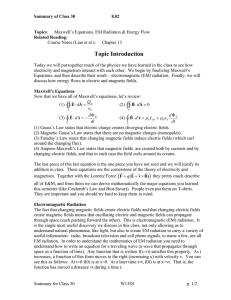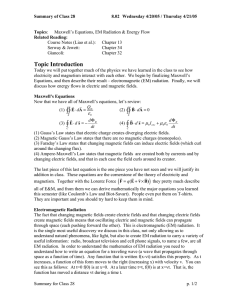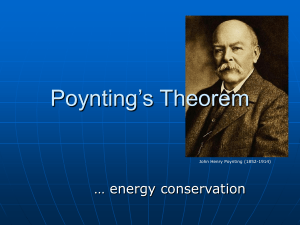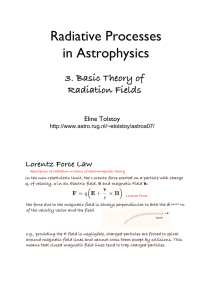Topic Introduction
advertisement
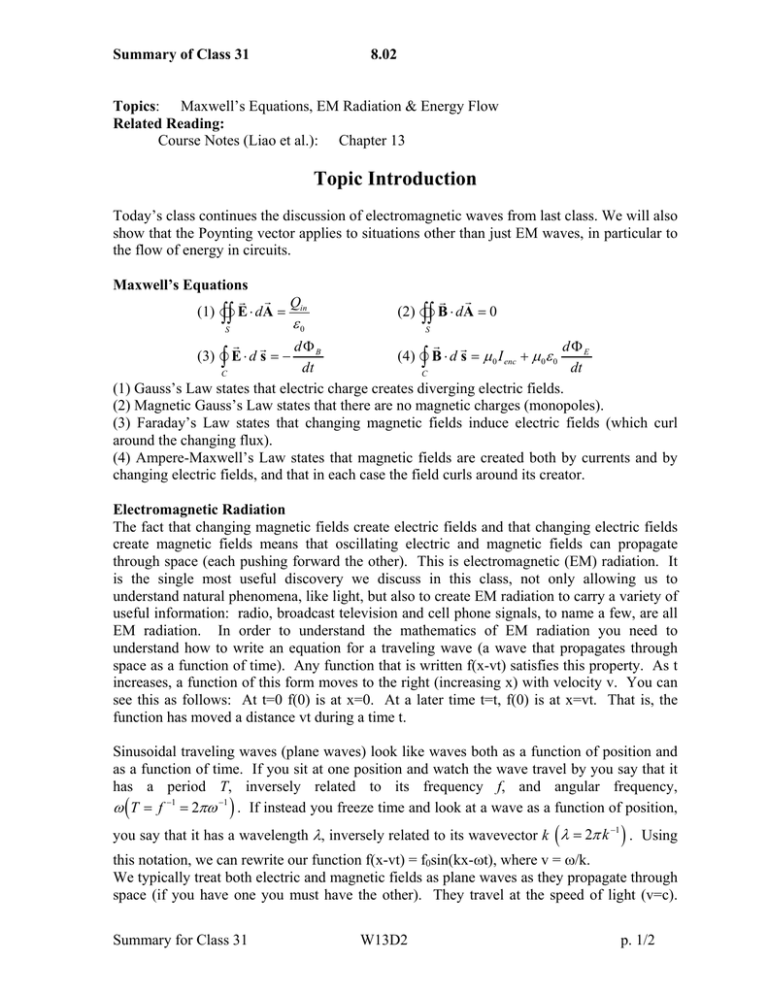
Summary of Class 31 8.02 Topics: Maxwell’s Equations, EM Radiation & Energy Flow Related Reading: Course Notes (Liao et al.): Chapter 13 Topic Introduction Today’s class continues the discussion of electromagnetic waves from last class. We will also show that the Poynting vector applies to situations other than just EM waves, in particular to the flow of energy in circuits. Maxwell’s Equations G G Qin G G (1) w E ⋅ d A = (2) B ∫S∫ w ∫S∫ ⋅ dA = 0 ε0 G G G G dΦ B dΦ E (3) v∫ E ⋅ d s = − (4) v∫ B ⋅ d s = µ 0 I enc + µ 0ε 0 dt dt C C (1) Gauss’s Law states that electric charge creates diverging electric fields. (2) Magnetic Gauss’s Law states that there are no magnetic charges (monopoles). (3) Faraday’s Law states that changing magnetic fields induce electric fields (which curl around the changing flux). (4) Ampere-Maxwell’s Law states that magnetic fields are created both by currents and by changing electric fields, and that in each case the field curls around its creator. Electromagnetic Radiation The fact that changing magnetic fields create electric fields and that changing electric fields create magnetic fields means that oscillating electric and magnetic fields can propagate through space (each pushing forward the other). This is electromagnetic (EM) radiation. It is the single most useful discovery we discuss in this class, not only allowing us to understand natural phenomena, like light, but also to create EM radiation to carry a variety of useful information: radio, broadcast television and cell phone signals, to name a few, are all EM radiation. In order to understand the mathematics of EM radiation you need to understand how to write an equation for a traveling wave (a wave that propagates through space as a function of time). Any function that is written f(x-vt) satisfies this property. As t increases, a function of this form moves to the right (increasing x) with velocity v. You can see this as follows: At t=0 f(0) is at x=0. At a later time t=t, f(0) is at x=vt. That is, the function has moved a distance vt during a time t. Sinusoidal traveling waves (plane waves) look like waves both as a function of position and as a function of time. If you sit at one position and watch the wave travel by you say that it has a period T, inversely related to its frequency f, and angular frequency, ω T = f −1 = 2πω −1 . If instead you freeze time and look at a wave as a function of position, ( ) ( ) you say that it has a wavelength λ, inversely related to its wavevector k λ = 2π k −1 . Using this notation, we can rewrite our function f(x-vt) = f0sin(kx-ωt), where v = ω/k. We typically treat both electric and magnetic fields as plane waves as they propagate through space (if you have one you must have the other). They travel at the speed of light (v=c). Summary for Class 31 W13D2 p. 1/2 Summary of Class 31 8.02 They also obey two more constraints. First, their magnitudes are fixed relative to each other: E0 = cB0 (check the units!) Secondly, E & B always oscillate at right angles to each other and to their direction of propagation (they are transverse waves). That is, if the wave is traveling in the z-direction, and the E field points in the x-direction then the B field must point along the y-direction. More generally we write Eˆ × Bˆ = pˆ , where pˆ is the direction of propagation. Energy and the Poynting Vector As EM Waves travel through space they carry energy with them. This is clearly true – light from the sun warms us up. It also makes sense in light of the fact that energy is stored in electric and magnetic fields, so if those fields move through space then the energy moves with them. It turns out that we can describe how much energy passes through a given area G G G per unit time by the Poynting Vector: S = µ10 E × B . Note that this points in the direction of propagation of the EM waves (from above) which makes sense – the energy is carried in the same direction that the waves are traveling. The Poynting Vector is also useful in thinking about energy in circuit components. For example, consider a cylindrical resistor. The current flows through it in the direction that the electric field is pointing. The B field curls around. The Poynting vector thus points radially into the resistor – the resistor consumes energy. We will repeat this exercise for capacitors and inductors in class. Important Equations (1) Maxwell’s Equations: EM Plane Waves: Poynting Vector: Summary for Class 31 G G w ∫∫ E ⋅ dA = S Qin ε0 (2) G G w ∫∫ B ⋅ dA = 0 S G G dΦB (3) v∫ E ⋅ d s = − dt G GC G E ( r , t ) = E0 sin ( kpˆ ⋅ r − ω t ) Eˆ G G G B ( r , t ) = B0 sin ( kpˆ ⋅ r − ω t ) Bˆ G G G S = µ10 E × B W13D2 (4) G G v∫ B ⋅ d s = µ I 0 enc C + µ 0ε 0 dΦE dt ˆ ω = ck with E0 = cB0 ; Eˆ × Bˆ = p; p. 2/2
